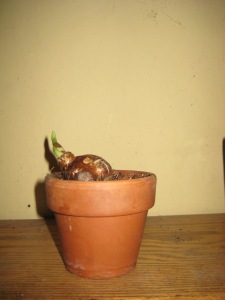 So for my New Year’s resolution, I have vowed to learn more about my favorite subject, and read a botany textbook. Cover to cover. Yes, indeed. I’m going to bone up on mosses and liverworts and the reproductive habits of ferns (which are amazingly kinky and involve swimming) and all the other wonders of botany. Hopefully this will be more successful than last year’s resolution involving exercise and weight loss.
So for my New Year’s resolution, I have vowed to learn more about my favorite subject, and read a botany textbook. Cover to cover. Yes, indeed. I’m going to bone up on mosses and liverworts and the reproductive habits of ferns (which are amazingly kinky and involve swimming) and all the other wonders of botany. Hopefully this will be more successful than last year’s resolution involving exercise and weight loss.
So I scouted my bookshelves for a botany book, and unearthed an ancient one—an old college textbook of my father’s, published two short years before I was born. And sadly, while it has tremendous sentimental value for me, it is, botanically speaking, a dinosaur.
Reading it is like a trip back in a time machine. The book has the same worldview as Linnaeus did when he divided the world into only two kingdoms, plant and animal, in the early 1700s. This ancient tome has fungi listed as a plant instead of giving it its own Kingdom, and ignores bacteria altogether. Written in a more innocent era, the book is blissfully ignorant of biotechnology, cloning, pesticide perils, and genetic modification. It references not a single website. It has black and white illustrations. It was obviously copied onto parchment by monks some time back in the Dark Ages.
So, recognizing the need to be accurate and up-to-date in my botanical meanderings, I’ve been on the look-out for another botany book. And (here is serendipity at work, or something) I wandered into the local library’s end-of-year-dumping-of-boring-books-no-one-wants sale, and there on the shelf, for fifty cents, was a botany textbook. One that was published in the twenty-first century.
It has colored photographs. Internet links for videos and other virtual information. Discusses biotechnology in detail.  And it also feels the need to point out apologetically that while it’s true that evolution is only a theory, it does seem to be quite well supported by scientific evidence. Sometimes you wonder what direction progress is progressing in…
And it also feels the need to point out apologetically that while it’s true that evolution is only a theory, it does seem to be quite well supported by scientific evidence. Sometimes you wonder what direction progress is progressing in…
Anyway. Both books agree on one thing—the diversity, beauty, and just general amazingness of plants.
A bulb. A little wrinkly papery round thing that looks like an onion. Put it in a flowerpot, add water and wait.
A new beginning. A new year. Here’s to keeping resolutions.





Recent Comments